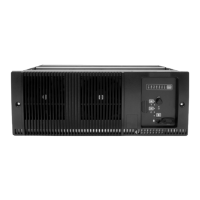128 Technical Description TB9100/P25 CG/P25 TAG Installation and Operation Manual
© Tait Limited March 2014
Auxiliary Power
Supply
This power supply board is mounted on the DC module. The input power
is provided from the high current 28 VDC output from the AC converter
or DC converter (depending on which is operating). It provides a regulated
13.65VDC, 27.3VDC or 54.6VDC output (depending on the model) of up
to 40W to power external accessory equipment. It can be configured using
the CSS to operate whenever AC mains voltage is available, or under Task
Manager control.
Notice While the auxiliary power output can be used for more than
one purpose at once, this is generally not recommended. It can result in
a short-circuit and equipment damage. The output is floating. If it is con-
nected to a negatively earthed battery and to positively earthed auxiliary
equipment, it will short-circuit.
Microprocessor The microprocessor on the HVDC control card monitors and controls the
operation of the PMU. There are no manual adjustments in the PMU
because all the calibration voltages and currents required to control and
protect the PMU are monitored by the microprocessor. The software also
automatically detects the PMU configuration and controls the PMU
accordingly.
If any of the monitored conditions exceeds its normal range of values, the
microprocessor will generate an alarm and take appropriate action,
depending on the configuration of the PMU.
The alarms and diagnostic functions are accessed through I
2
C bus messages
on the system control bus via the reciter, control panel and CSS.
The operation of the cooling fan mounted on the front panel is determined
by the temperature limits set in the PMU software.
Notice In base station systems that use a PMU, the PMU must be con-
nected to the system control bus at all times. The I
2
C current source is
located in the PMU, and if the PMU is disconnected, the state of much
of the bus will be undefined. This may cause corrupted data to be present
on the bus when the reciter reads the states of the switches on the control
panel. This in turn may result in random actuations of microphone PTT,
and carrier or speaker key, causing the base station to transmit, or the
speaker to be actuated, incorrectly.
Indicator LEDs The indicator LEDs on the front panel are used to indicate the state of the
PMU and its microprocessor. There are two LEDs, one red and one green.
Each LED can be on, off, or flashing at two rates (fast or slow). The state of
these LEDs can indicate a number of operating modes or fault conditions,
as described in Table 8.1 on page 129.

